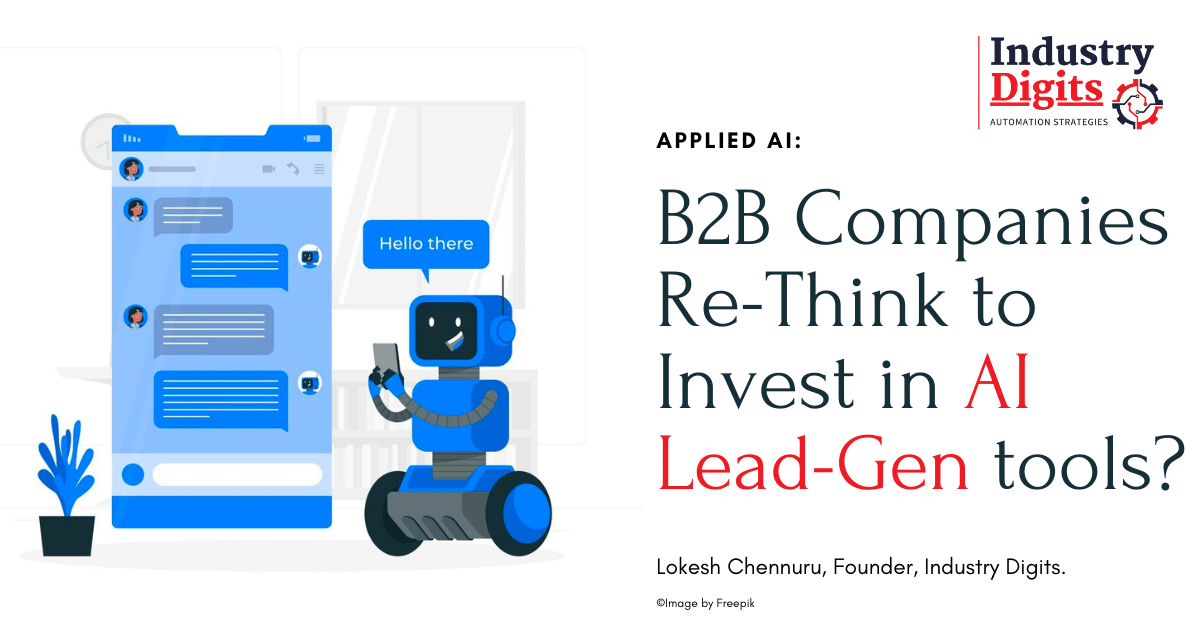AI Automation for B2B: Approaches to Boost Your Company Efficiency
AI automation in the B2B sector offers an essential chance for organizations to boost their performance. By enhancing processes and improving decision-making, businesses can accomplish substantial effectiveness. The effective integration of AI calls for careful consideration of numerous factors. Comprehending which locations to automate and choosing appropriate devices are just the beginning. The potential for change elevates crucial concerns concerning application and continuous examination. What strategies will guarantee long-term success in this developing landscape?
Comprehending AI Automation in B2B Context
As services progressively seek efficiency and technology, recognizing AI automation in the B2B context becomes crucial. AI automation leverages advanced technologies to improve procedures, enhance decision-making, and boost overall efficiency. By integrating AI tools, business can enhance operations such as supply chain administration, consumer relationship management, and data evaluation. These technologies can analyze vast amounts of information quickly, giving actionable understandings that drive critical campaigns. Additionally, AI-driven automation reduces human error and liberates staff members to concentrate on even more complex tasks. By promoting collaboration between human intelligence and machine capacities, organizations can attain a competitive side. Eventually, comprehending AI automation is important for B2B organizations aiming to grow in a significantly digital market.
Identifying Locations for Automation
In the mission for effective AI automation in B2B, it is important to determine particular locations where automation can produce considerable advantages. This consists of assessing job repetitiveness, exploring chances for data handling, and pinpointing operations bottlenecks. By focusing on these facets, organizations can streamline operations and boost efficiency.
Job Monotone Evaluation
Task repetitiveness analysis plays a necessary duty in identifying locations ripe for automation within B2B procedures. Minarik AI. This process involves assessing everyday tasks to figure out which are recurring and lengthy, thus preventing efficiency (AI Automation For B2B). By scrutinizing process, businesses can pinpoint details functions that call for excessive manual input, such as data access, invoice processing, or consumer follow-ups. Recognizing these repeated tasks permits organizations to allot resources a lot more effectively, improving general efficiency. Furthermore, automation can decrease human error, simplify operations, and maximize employees to concentrate on higher-value tasks. Conducting a complete task monotone assessment empowers B2B organizations to take on targeted automation strategies, eventually driving boosted efficiency and affordable benefit in the marketplace
Data Handling Opportunities

Workflow Traffic Jam Identification
Recognizing process bottlenecks is a vital action in recognizing the full benefits of automation within B2B organizations. These bottlenecks frequently show up as delays, source constraints, or ineffective procedures that prevent performance. To properly determine these areas, businesses can perform detailed evaluations of their process, using metrics such as cycle time and throughput. Engaging employees in discussions about pain factors can additionally supply valuable understandings. Organizations can prioritize them based on influence and feasibility for automation when bottlenecks are identified. By strategically addressing these inefficiencies, B2B companies can enhance procedures, enhance partnership, and eventually enhance total efficiency. This aggressive method to workflow evaluation lays the foundation for successful automation efforts that drive service growth.
Choosing the Right AI Devices and Technologies
As companies significantly transform to AI to enhance their operations, picking the right tools and modern technologies ends up being crucial for accomplishing wanted outcomes. Organizations needs to review their certain demands and objectives, thinking about variables such as scalability, compatibility, and user-friendliness. A thorough market analysis can assist determine leading AI remedies customized for their industry. Additionally, companies ought to assess the technical framework called for to sustain these devices, making sure smooth assimilation with existing systems. Information security and compliance with regulations are likewise vital factors to consider that influence tool option. By focusing on these standards, firms can make enlightened decisions that drive performance and efficiency, eventually resulting in enhanced company performance. The best AI tools encourage organizations to innovate and maintain an one-upmanship on the market.
Establishing a Tactical Application Strategy
A successful critical implementation plan for AI automation in B2B requires clearly specified essential goals. Additionally, companies need to examine their existing capacities to determine gaps and possibilities for enhancement. Constant monitoring and change of the method will assure positioning with developing business demands and technology improvements.
Define Key Goals
To ensure effective AI automation in B2B environments, specifying essential purposes is crucial for developing a tactical execution plan. Organizations has to determine particular, quantifiable objectives that align with their general service method. This quality offers a roadmap for the automation procedure, ensuring that initiatives are concentrated on locations that will produce the greatest impact. Key goals may consist of improving operational effectiveness, boosting client contentment, or boosting profits. Setting these goals makes it possible for teams to focus on sources effectively and track development over time. Furthermore, clear purposes help with better interaction among stakeholders, cultivating partnership and placement throughout the organization. Eventually, distinct objectives work as the foundation for a robust AI automation technique that drives service performance.
Examine Existing Capacities
Prior to applying AI automation, organizations should completely examine their present abilities to recognize toughness and weak points. This assessment entails checking out existing technologies, labor force abilities, and operational processes. By conducting a comprehensive audit, companies can pinpoint locations that require renovation or financial investment. Organizations must likewise consider their data management practices, as the quality my company and accessibility of information are vital for successful AI integration. Understanding the existing technological landscape allows firms to straighten their sources and capabilities with their tactical objectives. In addition, it is vital to review company culture and preparedness for modification, as these elements greatly influence the adoption of AI solutions. This analysis functions as the structure for developing a strategic execution plan that maximizes the possibility of AI automation.
Display and Change
Executing AI automation calls for a dynamic strategy that emphasizes continual tracking and change. Companies must create a tactical execution strategy that integrates regular evaluations of AI performance versus predefined metrics. This involves monitoring vital efficiency indications (KPIs) to evaluate the performance of automation remedies. By assessing data, companies can recognize areas for renovation and tweak their AI systems as necessary. Engaging with stakeholders throughout the process ensures that the automation straightens with service purposes and user requirements. Furthermore, cultivating a culture of versatility permits firms to respond swiftly to transforming market conditions and technological advancements. Growth Systems For B2B. Eventually, recurring monitoring and adjustment not only improve functional effectiveness however likewise drive continual service efficiency in the affordable B2B landscape
Ensuring Data Quality and Integration
As organizations progressively rely upon AI automation in B2B procedures, making certain data top quality and assimilation comes to be essential for success. High-grade data is vital for precise analytics, notified decision-making, and efficient client involvement. Information have to be cleansed, standard, and confirmed to remove mistakes and incongruities that can bring about illinformed insights. Furthermore, seamless assimilation throughout numerous systems and systems is imperative; diverse data silos hinder automation initiatives and reduce functional effectiveness. Organizations ought to adopt robust data governance structures and use sophisticated tools to help with data assimilation while preserving quality requirements. By focusing on these aspects, services can enhance their AI automation campaigns, inevitably leading to boosted performance and an affordable advantage in the B2B landscape.
Determining Success and ROI of AI Initiatives
How can companies successfully measure the success and roi (ROI) of their AI initiatives? To gauge effectiveness, organizations should develop clear, quantifiable objectives straightened with calculated purposes. Secret performance indications (KPIs) such as cost financial savings, profits growth, and performance enhancements can provide useful insights. Organizations often carry out standard evaluations prior to executing AI, allowing them to compare pre- and post-implementation metrics. In addition, analyzing client fulfillment and engagement can disclose the influence of AI on individual experience. Consistently evaluating these metrics helps in refining AI methods and ensuring positioning with organization goals. By using a structured method to dimension and evaluation, companies can properly evaluate the performance of their AI initiatives and make educated choices about future investments.
Getting Rid Of Obstacles in AI Fostering
Although lots of organizations recognize the potential of AI to transform their procedures, they typically run into significant challenges during adoption. Key hurdles include an absence of competent employees, which hampers the effective implementation and management of AI modern technologies. Organizations additionally face integration issues, as existing systems may not work with brand-new AI remedies. Additionally, concerns concerning information privacy and safety can lead to hesitance in fully embracing AI abilities. Resistance to transform from staff members can further make complex the change, demanding comprehensive training and communication techniques. To get rid of these difficulties, organizations ought to buy skill advancement, guarantee robust information administration, and foster a society that welcomes technology, inevitably leading the method for successful AI integration and enhanced organization efficiency
Frequently Asked Questions
Just How Can AI Automation Improve Client Partnership Monitoring in B2B?
AI automation can improve customer partnership administration in B2B by streamlining communication, giving individualized interactions, assessing customer information for insights, automating follow-ups, and boosting reaction times, ultimately promoting more powerful connections and driving sales development.
What Industries Benefit Most From AI Automation in B2B?
Production, finance, health care, and logistics industries benefit most from AI automation in B2B. These fields utilize automation to improve procedures, enhance data evaluation, improve consumer interactions, and inevitably increase operational performance and productivity.
How Does AI Automation Effect Staff Member Roles in B2B Business?
AI automation transforms employee duties in B2B companies by enhancing jobs, decreasing recurring work, and enabling personnel to concentrate on strategic efforts. This shift enhances efficiency and promotes a society of development and versatility.
What Are the Prices Related To Implementing AI Automation?
The expenses related to implementing AI automation include preliminary software program acquisition, infrastructure upgrades, training expenses, continuous maintenance, and prospective combination obstacles. Growth Systems For B2B. Business must likewise take into consideration lasting operational shifts and worker adjustment expenditures in their financial planning
Just How Can Businesses Make Sure Moral AI Usage in Their Operations?
Businesses can assure moral AI use by establishing clear guidelines, advertising openness, performing regular audits, involving varied stakeholders, and focusing on data privacy. Constant training and recognition programs better enhance understanding and adherence to ethical practices.
